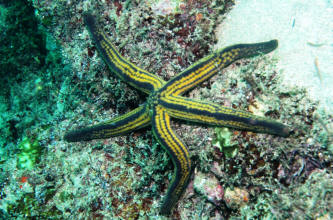|
Related FAQs: Sea Stars 1, Sea
Stars 2, Sea Stars 3, Sea Stars 4, Sea
Stars 5, Brittle Stars,
Seastar ID 1, Seastar ID 2, Seastar ID 5, Seastar ID 6 & Seastar Selection, Seastar Compatibility, Seastar Behavior, Seastar Systems, Seastar Feeding, Seastar Reproduction, Seastar Disease, Seastar Disease 2, Seastar Disease 3,
Star Disease 4, Star
Disease 5, & Asterina Stars, Chocolate Chip Stars, Crown of Thorns Stars, Fromia Stars, Linckia Stars, Linckia Stars 2, Sand-Sifting
Stars,
Related Articles:
Echinoderms, An Introduction to the
Echinoderms: The Sea Stars, Sea Urchins, Sea Cucumbers and
More... By James W. Fatherree, M.Sc. Brittle
Stars, Asterina Stars,
Crown of Thorns Seastars,
Marine
Scavengers,
Sea Stars, Class Asteroidea
part 10 of 11
To:
Part
1, Part 2, Part 3, Part
4, Part 5,
Part 6, Part 7,
Part 8, Part 9,
Part 11
|
|
|
By Bob Fenner
|
|
Genus Ophidiaster:
| Ophidiaster hemprichii Muller & Troschel
1842, Hemprich's Star. Legs round in cross section, of
variable color, usually reddish brown, with grey blotches. Body
made over with nine rows of articulating plates. To four inches
overall. Tropical Pacific. Kona pic. |

|
| Pharia/Phataria pyramidata (Gray 1840),
the Yellow-Spotted or Pyramid Star. Family Ophidiasteridae. To 9 inches in
diameter. Eastern Pacific; Sea of Cortez to Peru and the Galapagos, rocky
shores to 130 meters depth. Triangular shaped feet. Puerto Vallarta pic. |

|
| Phataria unifascialis (Gray 1840), the Blue Sea Star. Family
Ophidiasteridae. To 7 inches in diameter. Eastern Pacific; Sea of Cortez to
Peru and the Galapagos, rocky shores to 50 meters depth. Dorsal surface blue
or tan with black pebbled lines, underside orange. Algae feeder. Galapagos
pix below. |
To:
Part
1, Part 2, Part 3, Part
4, Part 5,
Part 6, Part 7,
Part 8, Part 9,
Part 11
|
|

